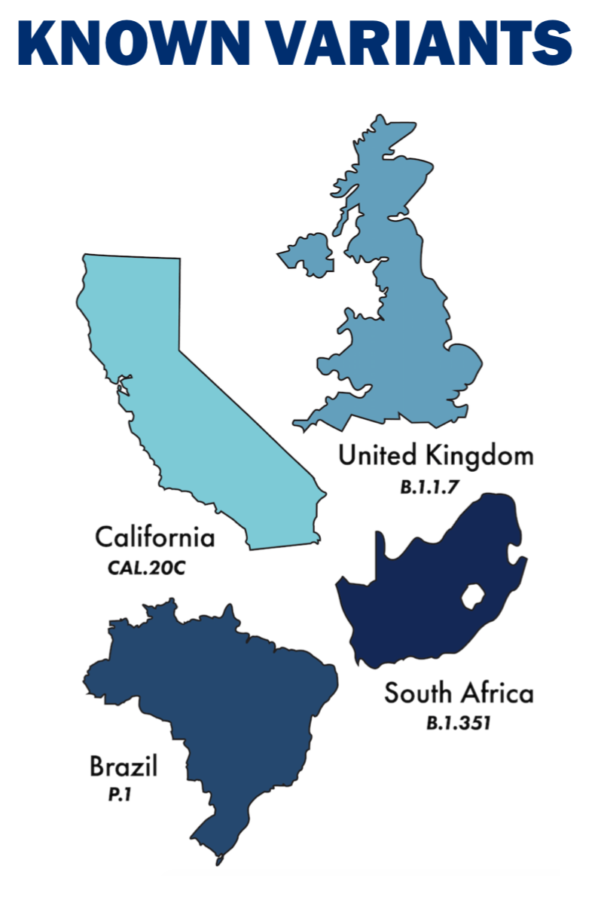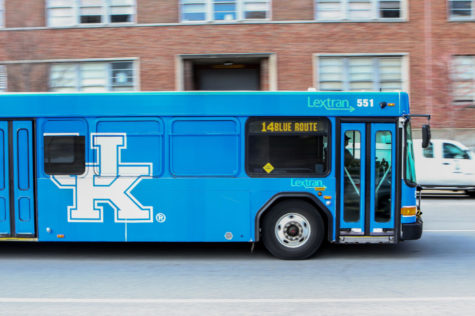What to know about COVID-19 variants
February 2, 2021
Pandemic lesson number one – global health is local health is personal health. That lesson has become clearer than ever in the past month, as emerging strains of the COVID-19 spread from their regions of origin to the United States.
Kentucky confirmed its first two cases of the United Kingdom variant, known as B.1.1.7, on Jan. 26, 2021. The following day, Gov. Andy Beshear included information on variants in his daily briefing.
Both cases were identified in Kenton County. Public health commissioner Dr. Steven Stack said people exposed to the strain are more likely to be infected.
“It’s not more dangerous for the person who gets it than the previous version of the virus, but since more people can get it more quickly and more easily, that means you could have more people get sick, more people who die,” Dr. Stack said.
Beshear and other officials said they expected these new viruses to arrive in Kentucky and were not surprised – and that they expect more cases.
The CDC has predicted the UK variant, which launched a new round of shutdowns in Britain, will become the dominant strain in the United States by March. So far 30 states, including neighbors Ohio, Indiana and Tennessee, have confirmed cases of the UK variant.
Preliminary studies out of the United Kingdom suggest that B.1.1.7 may be between 30 and 70 percent more contagious than earlier strains, meaning people should cut exposures by the same percentage.
Dr. Kathleen Winter, a professor in UK’s College of Medicine and infectious diseases expert, said it is important to remember that this is still a novel virus, meaning this is the first time it has had a human host and mutations are expected.
“The virus is adapting to the host and we’re adapting to the virus and we’re trying to fight the virus just as much as the virus is trying to fight us,” Dr. Winter said.
Scientists are not sure yet why the new variants are more contagious, though one theory is that sick people shed more of the virus.
“The limited information we do have on this is that it is thought to be more infectious, so that the virus itself can probably invade the human cells more easily than the prior variants that were circulating are and still are circulating. And so, that means a smaller amount of virus can likely cause you to get sick,” Dr. Winter said. She warned that everyone should take the pandemic more seriously than before in light of the new strains.
“Even people who have become sick and recovered, they may still be susceptible again, because this is a mutated strain or because they’re immunity has waned,” Winter said. “So I do think there’s some complacency out there because a lot of people have this and a lot of people know people who have had this and not been very sick.”
But she reiterated that the measures that people are already following, like social distancing and masks, do work against variants.
“Not gathering in close contact in groups of people, not going to lots of restaurants and bars,” Dr. Winter cautioned. “There’s a whole bunch of people there, the gym, those types of activities. But it’s hard because everyone’s tired. It’s like almost like this, couldn’t come at a worse time.”
The CDC and other health organizations have yet to issue a recommendation for double mask-ing, but multiple scientists and experts have suggested doing so in indoor situations. Dr. Anthony Fauci said double masking is “common sense.”
Dr. Winter said that as far as masks go, the most important thing is to make sure a mask fits well – snugly, over the nose and with few gaps – and has multiple layers.
“If you have a good well fitted mask, that’s fitted, you probably don’t need another layer. But if it does help you or it makes you feel like it’s sealing to your face a little better or you’re not messing with it as much, then that’s probably a good idea,” Dr. Winter said.
One of the major recommendations from scientists was to stop gathering indoors. For students who have to go to class in person, Dr. Winter said there are encouraging studies that very little transmission happens within a properly spaced class.
“We do see spread when people are socializing and mixing during sporting events or activities where there’s a lot more close contact, but probably going to class where people are wearing masks and you’re not hanging out before class together in the hallway or studying together in close proximity, that probably is a pretty low-risk activity.” She is more concerned about the variants emerging in South Africa and Brazil.
“They may cause more severe disease, and there’s some very limited suggestion that the vaccines may not work as well,” Dr. Winter said.
Pfizer and Moderna have reported that their vaccines are less effective against the South African variant than they are against the UK variant and the predominant strain in the U.S. Both companies are exploring the idea of a third “booster shot” that would be more effective against known variants.
One state – South Carolina – has confirmed a case of B.1.351, a strain that originated in South Africa and may be more contagious and more lethal.
Minnesota is the only state to report a case of P.1, a variant identified in Brazil in December after causing a massive surge in Manaus despite most of the city’s population having had other strains of COVID-19.
Efforts to identify variants and where they are spreading in the United States have been hampered by a lack of surveillance genetic testing.
The University of Kentucky, which requires mandatory testing for students, will not add testing for variant identification to its plan, according to spokesperson Jay Blanton.
Dr. Winter urged students to remember that, variant or no variant, they play a key role in community spread and can bring disease to others without getting severely ill themselves.
“They themselves can spread and propagate disease, without realizing it and we know that college students are in stores also working through all kinds of different jobs,” said Dr. Winter of college students. “So I think that’s another place to really be sure that your people are thinking, you know, not only do I want to protect myself but I need to make sure I’m not part of this transmission chain.”




















































































































































